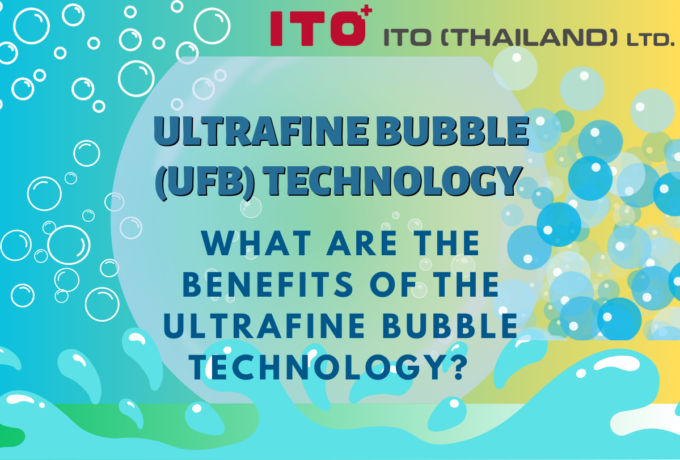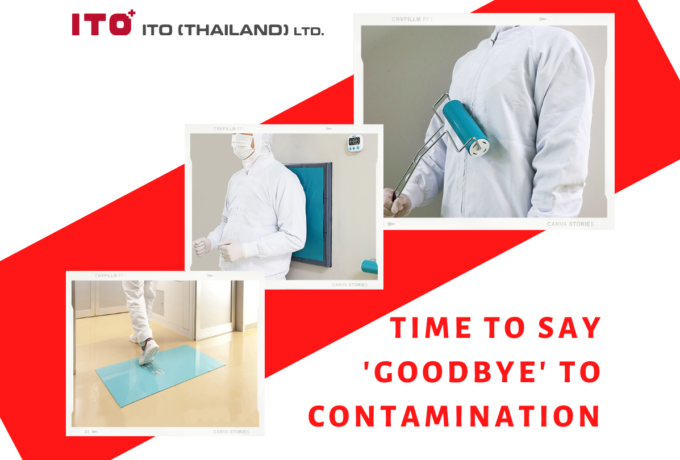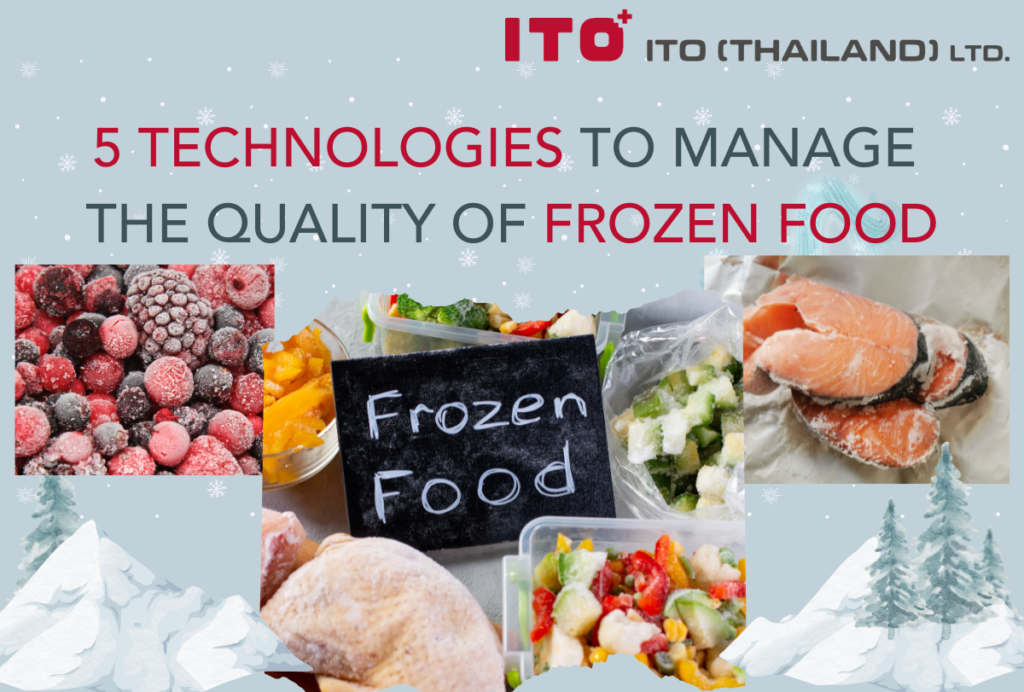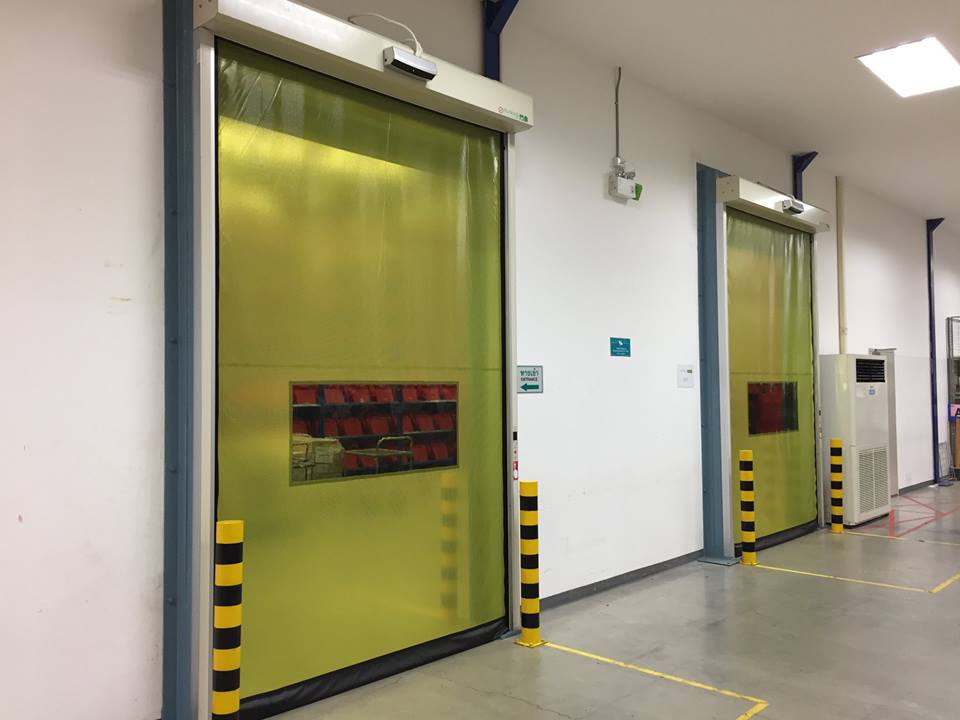ITO Thailand Hygiene Blog
Frozen food storage management
Freezing is a method of food preservation commonly used in food that goes bad quickly such as ready-to-cook fresh food, ready meals, or foods in which nutritional values decay easily, or have substances that are sensitive to temperature, light, oxygen, etc. Freezing uses a principle of quickly solidifying water in the products, making the molecules of the substances unable to react to one another, thus the foods last longer. It also suppresses the growth of microorganisms and kills parasites. For instance, USFDA (1) suggested controlling parasites in fish consumed raw such as sushi and sashimi by freezing the fish at the minimum of 20 degrees Celsius for 7 days or stored at -35 degrees Celsius for 15 hours to control parasites in fish (conditions may depend on the size of the fish as well).
How does frozen food decay?
Generally, decay of frozen food is typically caused by changes in the quality of food (2) that affect the consumers’ acceptance more than the safety aspect. The changes can be physical – movements of water in the system if the temperature decreases at a speed that is not fast enough during freezing, the water in the food system may move following the osmotic pressure. This will result in humidity loss in food cells, cell wall damage, loss of good texture, and more drip loss when the food is thawed. During storage, if the condition is not favorable i.e., temperature fluctuation, the ice crystals may become so enlarged that they damage the texture or the cell walls of the food, and freezer burn may ensue due to loss of surface humidity of food stored in inappropriate packaging. Chemical changes may be caused by chemical reactions of enzymes, fat oxidation, protein denaturation, deterioration of flavor, color, or functional substances such as vitamins, etc. (3) As for microbial growth, it is not usually an important issue in the frozen condition because it can be suppressed. However, if the temperature fluctuates extensively, microbial growth may potentially return. In addition, freezing only suppresses the microbial growth, it does not entirely remove the microorganisms. Therefore, taking into account good hygiene in the production process is still necessary to prevent microbial cross-contamination to keep the food as safe as possible.
Changes that occur in frozen food will have a faster rate of deterioration if the temperature fluctuates or there is a period where the temperature is higher than it should be. Examples are defects of chillers or the electric system, loss of temperature of insufficiently insulated walls, loss of temperature from opening the door, water condensation near the door preventing it from being tightly closed, etc. These make the food go bad more quickly than expected to the point that the quality is unacceptable to the consumers, or the microbial growth exceeds the safety level.
5 technologies to manage the quality of frozen food
Nowadays, technology and innovation have played a role in the frozen food industry to improve the quality of the frozen food and the efficiency of energy consumption. The role is different in each aspect ranging from recipe development to good factory infrastructure. The technologies can be divided as follows:
1.Food additives
At present, there is a group of substances called cryoprotectants that can help reduce food texture damage from freezing and thawing. The substances are divided into those with small molecules able to penetrate into cells and protect them from damage such as dimethyl sulfoxide and proline, and large molecules working outside the cells by using mechanisms that help adjust the ice crystal form to lessen the adverse effect of the cells, such as antifreeze proteins, Polyvinyl alcohol, polyampholytes, etc.(4) These agents reduce the growth of ice crystals that may penetrate the cells or make the food texture bad or can help lower the freezing point of the system. Therefore, putting these additives in the development of frozen recipes is an alternative to improve the quality of frozen food.
2.Pretreatment
The use of other processes can help reduce changes in frozen food quality, such as blanching to inhibit enzymes that cause food to change its color, smell, and flavor, commonly used in fruits and vegetables (2), or adding quality improvers (smell, taste, texture or cryoprotectant, etc.) into food before freezing. Pressure may be applied to help push the substances into the food.(5)
3.Novel freezing technology
Novel methods of freezing food are intended to increase the freezing rate and the economic value(2) , for example, applying pressure during freezing reduces the formation of ice crystals or impingement jet freezing for a faster freezing rate, etc.
4.Temperature fluctuation monitoring
Monitoring temperature fluctuation is an indirect indication of the quality of frozen food. This is because the deterioration of this food group is often related to temperature. There may be indicators or the use of sensors to set up a system to monitor the quality of the whole system in real-time.
5.Entrance temperature control
The entrance to the warehouse, whether for the people or freight trucks, is the point that is most vulnerable to temperature changes in the cold storage system for food storage. In addition to the loss of cooling temperature, in the event that the area is highly humid, it may cause condensation and ice crystals to form around the door(2) . This may result in the door being more difficult to close or cannot be completely closed, causing the temperature in the cold room to fluctuate higher and affecting the quality of frozen food stored in the room.
ITO (Thailand) recommends a high-speed door from Japan. They are special models for cold rooms made with specialized canvas. They can support temperatures from -25 to 5°C without freezing and allow the inside to be clearly seen. The system is equipped with a heater with an operating system to prevent the formation of ice crystals on the edge of the door.
If you are interested in the product, you can contact us to see the sample product at our showroom or consult us to install the door at your site. We are happy to be of service.
Reference
1.Parasites. [Online]: https://www.fda.gov/media/80777/download
2.Evans, J. A. (Ed.). (2009). Frozen food science and technology. John Wiley & Sons.
3.Zaritzky, N. (2006). Physical–chemical principles in freezing. In: D.W. Sun, ed. Handbook of Frozen Food Processing and Packaging. Boca Raton, FL: CRC/Taylor & Francis Group, pp. 3–33.
4.Liu, X., Pan, Y., Liu, F., He, Y., Zhu, Q., Liu, Z., … & Tan, S. (2021). A review of the material characteristics, antifreeze mechanisms, and applications of cryoprotectants (CPAs). Journal of Nanomaterials, 2021.
5.Sriwimon, W., & Boonsupthip, W. (2011). Utilization of partially ripe mangoes for freezing preservation by impregnation of mango juice and sugars. LWT-Food Science and Technology, 44(2), 375-383.
Related Post
-

Liquid nitrogen in food industry
You maybe have heard that liquid nitrogen can rapidly freeze the food, haven’t you? And what are its advantages and benefits? Let's get to know the liquid nitrogen in food industry with ITO (Thailand).
-

Ultrafine bubble (UFB) technology (Part 2)
The previous content has discussed the benefits of the ultrafine bubble technology in agriculture, livestock, and fisheries, cleaning raw materials and various surfaces. Today, we will continue to learn about the use of the ultrafine bubble technology in food production processes and waste management from the food industry and how to create these tiny gas bubbles.
-

Ultrafine bubble (UFB) technology (Part 1)
Simple bubbles when transformed into the micro-nano level can do more than you think. Let's learn about the technology of these tiny bubbles and their application in the food industry with ITO (Thailand).
-

Boot Cleaner
Pay attention to the hygiene of the footwear for good hygiene in the food industry
-

Innovation for sustainable physical contamination prevention
It is known that external impurities pose a food safety risk. One of the main channels of contamination is the presence of humans as a carrier of dust and dirt into the production or high-risk areas, causing dirt, germs, or foreign matters to contaminate food and harm consumers.
-

AI technology in Food industry world
Case study of HACCP assisted hand washing system by AI technology











